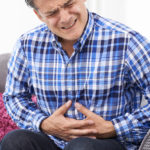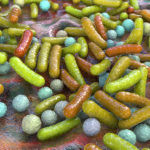By Bonnie Jenkins, Advanced Natural Wellness
Back in the days when I was a smart-aleck kid, I used to tease my dad relentlessly about his “horseshoe haircut.” Fortunately, he was a good sport about it. But many men are less jovial about their hair loss – and they’ll try practically anything to reverse the fallout.
If you’ve noticed your hair isn’t as thick as it once was, you’re not alone: By age 50, more than half of Caucasian men will have some degree of balding. And about 40 percent of women will be affected by the time they settle into their 70s. Aside from surgical plugs or dubious drugs, can herbs or nutrition help you hang on to your hair?
Bad Hair Days
There’s no getting away from it. Every time you look in the mirror, you see that receding hairline. Each day, there’s more hair left in your hair brush or clogging the shower drain. But, while you can see what’s happening on the outside, it’s also important to understand how hair loss begins inside your scalp.
Hair is produced by follicles, tiny bulb-shaped appendages embedded in your scalp. Most of these mini-factories are busily sprouting hair, but at any given time about 10 to 15 percent of them are resting. A resting follicle sheds its hair after a few months, then it starts production again. Normally, all of us shed about 50 to 100 of the more than 100,000 hairs on your head each day. But problems begin when too many follicles enter this rest phase permanently or are damaged or killed. When this happens, your rate of replacement may not keep up, eventually causing your hair to thin out visibly. This excessive hair loss is called alopecia.
The most common type of alopecia happens gradually over several years. Known as androgenetic alopecia, this type of hair loss results in a receding hairline or a balding crown. Susceptibility in men likely is linked to genetics and to conversion of the male hormone testosterone to DHT (dihydrotestosterone). DHT can force too many follicles into early retirement. In women, hormonal changes arising from menopause, aging and thyroid sluggishness might be at play. Many drugs, including beta blockers, anti-cholesterol medications and blood thinners, also can aggravate hair loss.
Another, less common type of alopecia, called alopecia areata, shows up as patchy areas that appear within weeks or months of an illness or allergic reaction. Common triggers include chemotherapy, advanced infections, severe allergies, autoimmune flare-ups and acute emotional stress. Remove the acute trigger, and hair usually grows back eventually with good nutrition.
MD Exposes the Hidden Danger to Your Eyes

When your eyesight starts to fail, it's a real problem. Suddenly you can't go to the grocery store... you can't get to the doctor if you have an emergency... you can't meet your friends for dinner…
Your "regular" doctor doesn't have time to keep up with the latest research. And the same goes for eye doctors. They go to school to learn how to fit you for glasses and contacts, but have no way of preventing the damage and loss of eyesight that threatens your freedom and independence.
Let me show you something that explains a LOT about how your eyes work.
In my FREE Special Report, I'll show you a HUGE, untapped resource for your eyes that safely and naturally restores clear, effortless eyesight.
Click here to get started...
Boost Your Antioxidants
There’s been a lot of focus lately on a family of flavonoids known as procyanidins – antioxidants that are present in many plants like apples, barley, grape seeds, cocoa, blueberries, green tea and rosehips. Japanese researchers have discovered that procyanidins help hair regrow in some balding men. Working with an apple procyanidin, the Japanese double-blind trial found that a twice-daily topical application of a 0.7 percent solution increased new hair production, whereas the untreated men continued to lose hair. After six months, the men receiving the treatment sprouted about three new hairs per square centimeter of treated scalp. While that might not sound like much, it adds up for better overall coverage.
Because procyanidins (also called oligomeric proanthocyanidins or OPC) are antioxidants, they neutralize damaging free radicals that can cause inflammation and damage hair follicles. Better yet, they block the production of DHT. Those inhibitors bind to hair follicles, redirecting them from active growth to rest. So far, the research has focused on men, but procyanidins might help some women whose alopecia is linked to an estrogen-testosterone imbalance.
Getting these hair-friendly antioxidants is easy. You can take 100 mg. of an OPC supplement like grapeseed extract or pycnogenol. For even more hair protection, consume more OPC-rich fruits and beverages like cranberry, black currant, green tea, black tea and red wine. On the flip side, certain foods may exacerbate hair loss. Saturated fats, for example, are pro-inflammatory, so you’d be wise to bypass the burgers and fries. For some people, allergies to dairy or animal products cause inflammation and hair loss.
Topical Stimulation
Rosemary has been used for centuries to treat hair loss and is widely recommended by natural-health practitioners for stimulating hair growth. According to the American Osteopathic College of Dermatology, rosemary applied topically can promote new cell growth in the scalp, at least in part by curbing the buildup of scalp oil (sebum), which can plug hair follicles.
Rosemary also contains an antioxidant and anti-inflammatory compound called rosmarinic acid. This major constituent reduces the production of leukotriene B4, an inflammatory chemical produced in the body and whose action might injure the follicle and contribute to excessive hair loss. Rosmarinic acid is also an antiviral and antibiotic, and helps disinfect the scalp. It is well absorbed from the skin or gastrointestinal tract, so even sipping a cup of rosemary tea might indirectly benefit your hair.
Preliminary research shows that rosemary might even help replenish bald patches. A double-blind study done in Scotland with sufferers of alopecia areata reported that a blend of rosemary and other essential oils accelerated hair regrowth. One group of patients had a daily scalp massage with the essential oils of rosemary, thyme, lavender and cedar in a carrier mixture of jojoba and grapeseed oils, while a second group used only the carrier oils. Two dermatologists then evaluated hair re-growth after seven months. Forty-four percent of those receiving the essential oils improved visibly compared to only 15 percent of the other group.
To use rosemary or other essential oils, add 3 to 4 drops to a tablespoon of a light-textured oil like jojoba, grapeseed or almond oil. Massage gently into the scalp, moving the skin over the bone rather than dragging your fingers across hair roots; leave in for about an hour, then wash hair as usual. Or add a few drops of essential oil (without carrier oil) to your shampoo.
The World's Quickest Solution for Ending Prostate and Urinary Misery
This has recently been revealed to be one of the only real breakthroughs in prostate health.
The seeds of a strange fruit (sometimes called "Chinese Apples") hold powerful phytonutrients that are a revolution in prostate health.
In fact, UCLA and Veterans Administration research have now proved this to be true.
Not only that, but it may be the worlds quickest solution for ending prostate misery.
Simply stated, these phytonutrients represent a huge step beyond beta sitosterol, saw palmetto, and other phytosterols alone.
Simply click HERE if you want to have fast prostate relief...restful, uninterrupted sleep...no more constant "urges to go"...enhanced virility...and optimal prostate support for life.
Feed Your Scalp
Hair follicles need food and oxygen to do their job. To ensure you’re getting enough of the right nutrients for healthy hair, make sure you include the following in your diet:
Essential fatty acids oxygenate cell tissues, reduce inflammation and transport fat-soluble vitamins A, D, E and K to hair follicles. Unfortunately, omega-3 fatty acids often are lacking in our diets. The best sources are flaxseeds, flaxseed oil or cold-water fish such as salmon. Other good sources are avocados, nuts and nut oils.
Zinc supports protein synthesis. Deficiencies of the mineral are typical in Western diets, which can also contribute to celiac disease and other inflammatory conditions that aggravate hair loss. Get zinc from oysters (the richest source) and other shellfish, lean red meats, skinless poultry or lowfat cheese. Or supplement with 30 mg a day.
Silicic acid (silica) helps maintain the integrity of blood vessel walls for good circulation. Superior sources are unrefined oats and other whole-grain cereals.
One Last Thing …
Most people know saw palmetto for its ability to treat prostate enlargement. But it may also help stem hair loss, thanks to its ability to disrupt the formation of DHT. Preliminary studies have shown that saw palmetto is just as effective as the prescription finasteride for hair loss.
The men were given either 200 mg. of saw palmetto and 50 mg. of beta-sitosterol twice a day or a matching placebo for 14 weeks. The patients were then asked to evaluate any changes in their hair. Assessments were also performed at baseline and at the study’s completion. Sixty percent of the subjects were rated as improved at the final visit.
If you’d like to give saw palmetto a try, most herbalists recommend taking 160 mg. twice a day. Look for a standardized supplement containing 85 to 95 percent sterols and lipids.
This Just In …
Got inflammation? That might depend on what you’re eating, say Greek researchers after they found that a diet rich in choline and betaine is linked to markers of inflammation. The researchers looked at 3,042 men and women, age 18 to 89, and found that those with the highest intakes of choline and betaine had the lowest levels of inflammatory markers, including C-reactive protein, homocysteine, interleukin-6 and tumor necrosis factor.
Choline helps make neurotransmitters and fats in cell membranes, while betaine helps reduce homocysteine levels. These findings suggest that both may be key to reducing inflammation, now considered a stepping stone to heart disease and other chronic conditions. So where do you find this dynamic duo? Rich sources of choline include eggs, wheat germ, pork, beef, cod, chicken, shrimp, salmon, oat bran, Brussels sprouts, broccoli and cauliflower. Betaine is highest in wheat bran, wheat germ, spinach, shrimp and beets.
References:
Detopoulou P, Panagiotakos DB, Antonopoulou S, et al. “Dietary choline and betaine intakes in relation to concentrations of inflammatory markers in healthy adults: the ATTICA study.” American Journal of Clinical Nutrition. 2008; 87: 424-430.
Hay IC, Jamieson M, Ormerod AD. “Randomized Trial of Aromatherapy: Successful Treatment for Alopecia Areata.” Archives of Dermatology. 1998;134: 1349-1352.
Hughes-Formella B, Wunderlich O, Williams R. “Anti-Inflammatory and Skin-Hydrating Properties of a Dietary Supplement and Topical Formulations Containing Oligomeric Proanthocyanidins.” Skin Pharmacology and Physiology. 2007;20:43-49.
Prager N, Bickett K, French N, et al. “A randomized, double-blind, placebo-controlled trial to determine the effectiveness of botanically derived inhibitors of 5-alpha-reductase in the treatment of androgenetic alopecia.” Journal of Alternative and Complementary Medicine. 2002;8:143-152.
Takahashi T, Kamimura A, Kagoura M, et al. “Investigation of the topical application of procyanidin oligomers from apples to identify their potential use as a hair-growing agent.” Journal of Cosmetic Dermatology. 2005; 4: 245-249





